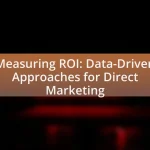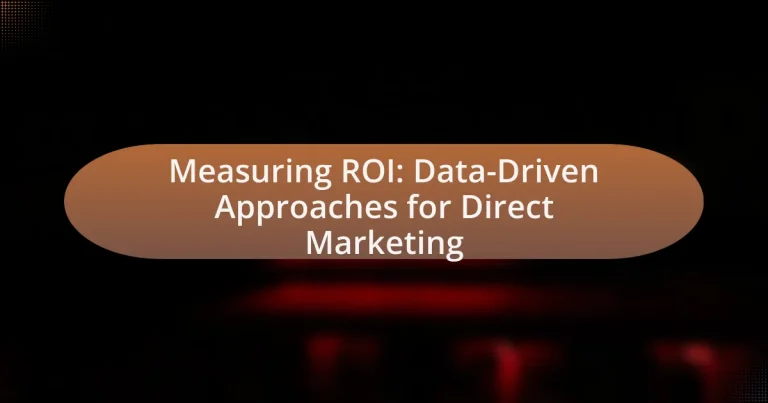Measuring ROI in direct marketing is a critical process that evaluates the financial return generated from marketing investments relative to their costs. This article outlines the definition of ROI in direct marketing, key metrics for measurement, and the importance of data-driven approaches in optimizing marketing strategies. It discusses the challenges marketers face in accurately measuring ROI, including data quality issues and attribution complexities, while also providing practical tips and best practices for enhancing ROI measurement. Additionally, the article highlights the role of customer segmentation and advanced analytics tools in improving decision-making and overall marketing performance.
What is Measuring ROI in Direct Marketing?
Measuring ROI in direct marketing refers to the process of evaluating the financial return generated from marketing investments relative to the costs incurred. This measurement is crucial for assessing the effectiveness of direct marketing campaigns, as it quantifies the profit or loss associated with specific marketing efforts. For instance, if a direct marketing campaign costs $10,000 and generates $50,000 in sales, the ROI can be calculated as (Revenue – Cost) / Cost, resulting in an ROI of 400%. This metric helps marketers make informed decisions about budget allocation and strategy optimization, ensuring that resources are directed toward the most profitable initiatives.
How is ROI defined in the context of direct marketing?
ROI, or Return on Investment, in the context of direct marketing is defined as the ratio of the net profit generated from a marketing campaign to the total cost of that campaign. This metric quantifies the effectiveness of marketing efforts by measuring how much revenue is earned for every dollar spent. For instance, if a direct marketing campaign costs $10,000 and generates $50,000 in sales, the ROI would be calculated as ($50,000 – $10,000) / $10,000, resulting in an ROI of 4, or 400%. This calculation allows marketers to assess the financial return of their campaigns and make informed decisions about future marketing strategies.
What are the key metrics used to measure ROI?
The key metrics used to measure ROI include net profit, total investment cost, and return on investment percentage. Net profit is calculated by subtracting total costs from total revenue, providing a clear indication of financial gain. Total investment cost encompasses all expenses related to the marketing campaign, including production, distribution, and promotional costs. The return on investment percentage is derived from the formula (Net Profit / Total Investment Cost) x 100, which quantifies the efficiency of the investment. These metrics are essential for evaluating the effectiveness of direct marketing strategies and guiding future investment decisions.
How do these metrics differ from traditional marketing ROI measurements?
Data-driven metrics differ from traditional marketing ROI measurements primarily in their focus on real-time data and customer behavior analytics. Traditional ROI measurements often rely on historical data and aggregate performance metrics, which can obscure the immediate impact of marketing efforts. In contrast, data-driven approaches utilize advanced analytics and tracking technologies to assess customer interactions and conversion rates in real-time, allowing for more precise attribution of marketing effectiveness. This shift enables marketers to make informed decisions quickly, optimizing campaigns based on current performance rather than relying solely on past trends.
Why is measuring ROI important for direct marketing campaigns?
Measuring ROI is crucial for direct marketing campaigns because it quantifies the effectiveness and profitability of marketing efforts. By calculating ROI, marketers can assess which campaigns yield the highest returns, enabling data-driven decisions that optimize budget allocation. For instance, a study by the Direct Marketing Association found that direct marketing campaigns generate an average ROI of $4.00 for every $1.00 spent, highlighting the financial impact of effective strategies. This measurement allows businesses to refine their approaches, improve targeting, and ultimately enhance overall marketing performance.
What impact does ROI measurement have on marketing strategy?
ROI measurement significantly influences marketing strategy by providing quantifiable insights into the effectiveness of marketing campaigns. By analyzing ROI, marketers can identify which strategies yield the highest returns, allowing for data-driven decision-making. For instance, a study by HubSpot found that companies that measure ROI are 1.6 times more likely to achieve their marketing goals. This data enables marketers to allocate resources more efficiently, optimize campaigns, and ultimately enhance overall performance.
How can ROI insights drive better decision-making?
ROI insights drive better decision-making by providing quantifiable data that highlights the effectiveness of marketing strategies. By analyzing return on investment, businesses can identify which campaigns yield the highest returns, allowing them to allocate resources more efficiently. For instance, a study by the Direct Marketing Association found that targeted direct marketing campaigns can generate an average ROI of 13:1, demonstrating the financial benefits of data-driven decision-making. This evidence enables companies to refine their marketing efforts, focus on high-performing channels, and ultimately enhance profitability.
What data-driven approaches can be used to measure ROI?
Data-driven approaches to measure ROI include customer lifetime value (CLV) analysis, attribution modeling, and A/B testing. CLV analysis quantifies the total revenue a business can expect from a customer over their entire relationship, providing a clear metric for evaluating marketing effectiveness. Attribution modeling assigns value to different marketing channels based on their contribution to conversions, allowing businesses to identify which strategies yield the highest returns. A/B testing involves comparing two versions of a marketing asset to determine which performs better, enabling data-backed decisions that enhance ROI. These methods are supported by industry practices, such as the use of analytics tools that track customer interactions and conversion rates, ensuring that businesses can make informed decisions based on empirical data.
How can data analytics enhance ROI measurement?
Data analytics enhances ROI measurement by providing precise insights into customer behavior and campaign performance. By analyzing data from various sources, businesses can identify which marketing strategies yield the highest returns, allowing for more informed decision-making. For instance, a study by McKinsey & Company found that companies using advanced analytics can improve their marketing ROI by 15-20%. This capability enables organizations to allocate resources more effectively, optimize marketing spend, and ultimately increase profitability.
What tools are available for data analysis in direct marketing?
Tools available for data analysis in direct marketing include customer relationship management (CRM) software, data visualization tools, and marketing analytics platforms. CRM software, such as Salesforce, helps businesses manage customer interactions and analyze data to improve relationships and retention. Data visualization tools like Tableau enable marketers to create visual representations of data, making it easier to identify trends and insights. Marketing analytics platforms, such as Google Analytics, provide comprehensive data analysis capabilities, allowing marketers to track campaign performance and measure ROI effectively. These tools collectively enhance the ability to analyze data and optimize direct marketing strategies.
How do these tools integrate with existing marketing systems?
These tools integrate with existing marketing systems through APIs and data connectors that facilitate seamless data exchange. By utilizing standardized protocols, such as RESTful APIs, these tools can pull and push data between platforms, ensuring that marketing teams have access to real-time analytics and performance metrics. For instance, platforms like HubSpot and Salesforce offer built-in integrations that allow for automatic synchronization of customer data, campaign performance, and ROI calculations, enhancing the overall efficiency of marketing efforts. This integration capability is crucial for maintaining a unified view of marketing performance and optimizing strategies based on accurate, up-to-date information.
What role does customer segmentation play in measuring ROI?
Customer segmentation plays a critical role in measuring ROI by enabling businesses to tailor their marketing strategies to specific groups, thereby enhancing the effectiveness of their campaigns. By dividing the customer base into distinct segments based on demographics, behaviors, or preferences, companies can allocate resources more efficiently and target their messaging, which leads to higher conversion rates. Research indicates that targeted marketing can increase ROI by up to 20% compared to non-segmented approaches, as it allows for more personalized engagement and better alignment with customer needs.
How can segmentation improve the accuracy of ROI calculations?
Segmentation can improve the accuracy of ROI calculations by allowing marketers to analyze performance metrics for distinct customer groups. By dividing the audience into segments based on demographics, behaviors, or preferences, marketers can identify which segments yield the highest returns on investment. For instance, a study by the Direct Marketing Association found that targeted marketing campaigns can generate up to 20 times the ROI compared to non-targeted efforts. This targeted approach enables more precise allocation of resources and tailored marketing strategies, ultimately leading to more accurate ROI assessments.
What types of customer data are most valuable for segmentation?
Demographic data, behavioral data, and psychographic data are the most valuable types of customer data for segmentation. Demographic data includes age, gender, income, and education level, which help identify distinct customer groups. Behavioral data, such as purchase history and website interactions, reveals patterns in customer actions and preferences. Psychographic data, which encompasses lifestyle, values, and interests, provides deeper insights into customer motivations. Research indicates that companies utilizing these data types for segmentation can achieve up to 20% higher conversion rates, demonstrating the effectiveness of targeted marketing strategies.
What are the challenges in measuring ROI for direct marketing?
Measuring ROI for direct marketing presents several challenges, primarily due to difficulties in accurately attributing revenue to specific marketing efforts. One significant challenge is the multi-channel nature of marketing campaigns, where customers may interact with various touchpoints before making a purchase, complicating the attribution process. Additionally, the lack of standardized metrics across different platforms can lead to inconsistent data, making it hard to compare results effectively.
Another challenge is the time lag between marketing activities and resulting sales, which can obscure the immediate impact of direct marketing efforts. Furthermore, external factors such as market conditions and consumer behavior changes can influence sales, making it difficult to isolate the effects of direct marketing initiatives. According to a study by the Direct Marketing Association, 70% of marketers struggle with accurately measuring the effectiveness of their campaigns, highlighting the widespread nature of these challenges.
What common obstacles do marketers face in ROI measurement?
Marketers commonly face several obstacles in ROI measurement, including data integration challenges, lack of standardized metrics, and difficulties in attributing revenue to specific marketing efforts. Data integration challenges arise when marketers struggle to consolidate data from various sources, leading to incomplete or inaccurate analyses. The lack of standardized metrics complicates comparisons across campaigns and channels, making it hard to assess performance consistently. Additionally, attributing revenue to specific marketing activities is often problematic due to the multi-touch nature of customer journeys, which can obscure the direct impact of individual marketing efforts. These obstacles hinder effective ROI measurement and decision-making in marketing strategies.
How can data quality issues affect ROI calculations?
Data quality issues can significantly distort ROI calculations by leading to inaccurate assessments of revenue and costs. When data is incomplete, inconsistent, or erroneous, it can result in miscalculations of both the investment made in direct marketing efforts and the returns generated from those efforts. For instance, if customer data is flawed, it may lead to targeting the wrong audience, thereby inflating costs and underreporting actual revenue generated from successful campaigns. Research indicates that organizations with high data quality can achieve up to 20% higher ROI compared to those with poor data quality, highlighting the critical role of accurate data in effective ROI measurement.
What strategies can be employed to overcome these challenges?
To overcome challenges in measuring ROI in direct marketing, businesses can implement data analytics tools and techniques. Utilizing advanced analytics allows organizations to track customer interactions and campaign performance in real-time, leading to more accurate ROI calculations. For instance, a study by the Data & Marketing Association found that companies using data-driven marketing strategies are six times more likely to be profitable year-over-year. Additionally, integrating customer relationship management (CRM) systems with marketing platforms can enhance data collection and analysis, providing deeper insights into customer behavior and campaign effectiveness.
How can marketers ensure accurate ROI measurement?
Marketers can ensure accurate ROI measurement by implementing a systematic approach that includes defining clear objectives, utilizing appropriate metrics, and leveraging data analytics tools. By establishing specific goals for each marketing campaign, marketers can align their efforts with measurable outcomes, such as conversion rates or customer acquisition costs. Utilizing metrics like customer lifetime value and return on ad spend provides a clearer picture of financial performance. Furthermore, employing data analytics tools allows for real-time tracking and analysis of campaign performance, enabling marketers to make informed adjustments. According to a study by HubSpot, companies that use data-driven marketing are six times more likely to be profitable year-over-year, highlighting the importance of data in achieving accurate ROI measurement.
What best practices should be followed for data collection?
Best practices for data collection include defining clear objectives, ensuring data quality, obtaining informed consent, and utilizing appropriate tools and methods. Clear objectives guide the data collection process, ensuring that relevant information is gathered to measure ROI effectively. Data quality is crucial; it should be accurate, consistent, and timely to support reliable analysis. Informed consent from participants is necessary to comply with ethical standards and legal requirements. Finally, using appropriate tools, such as surveys or analytics software, enhances the efficiency and effectiveness of data collection, allowing for better insights into direct marketing strategies.
How can continuous improvement be applied to ROI measurement processes?
Continuous improvement can be applied to ROI measurement processes by systematically analyzing and refining the metrics used to assess return on investment. This involves regularly reviewing data collection methods, ensuring accuracy in financial reporting, and adapting measurement frameworks to reflect changing market conditions. For instance, organizations can implement feedback loops that incorporate insights from previous campaigns to enhance future ROI calculations, thereby increasing the reliability of the data. Research indicates that companies employing continuous improvement methodologies, such as Lean or Six Sigma, often see a 10-30% increase in ROI due to more efficient processes and better decision-making based on accurate data.
What practical tips can enhance ROI measurement in direct marketing?
To enhance ROI measurement in direct marketing, businesses should implement precise tracking mechanisms for all marketing campaigns. Utilizing unique tracking codes for each campaign allows for accurate attribution of sales and leads to specific marketing efforts. Additionally, integrating customer relationship management (CRM) systems with marketing analytics tools provides a comprehensive view of customer interactions and their impact on revenue. According to a study by the Direct Marketing Association, targeted campaigns can yield a return on investment of up to 400%, highlighting the importance of data-driven strategies in measuring effectiveness. Regularly analyzing campaign performance metrics, such as conversion rates and customer acquisition costs, further refines ROI calculations and informs future marketing decisions.















